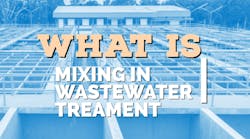What is PFAS?
Per- and polyfluoroalkyl substances (PFAS) are a family of more than 3,000 man-made chemicals that have been manufactured and used since the 1940s.
There are thousands of different PFAS, and perfluorooctanoic acid (PFOA) and perfluorooctane sulfonate (PFOS) are two of the most widely used and studied chemicals in the PFAS group.
According to the U.S. EPA, PFAS are found in: drinking water; manufacturing or chemical production facilities; food packaging; biosolids; fire extinguishing foam and more.
What is Sludge?
Sludge is defined by Merriam Webster as “a muddy or slushy mass, deposit, or sediment, such as precipitated solid matter produced by water and sewage treatment processes.”
According to EPA, sewage sludge that is treated and meets regulations is referred to as biosolids. 40 Code of Federal Regulations (CFR) Part 503 defines sewage sludge as “a solid, semisolid, or liquid residue generated during the treatment of domestic sewage in a treatment works.”
According to the Center for Food Safety, to create sludge, wastewater and storm water enter a sewage system and flow into wastewater treatment facilities, where solid wastes are separated from the liquid wastes and then digested or decomposed by bacteria.
How does PFAS End up in Sludge?
Sludge can contain hazardous materials, according to the Center for Food Safety. This includes household, medical, chemical, industrial waste, chemicals, metals and more.
Biosolids carry toxic chemicals, including PFAS. Several studies indicate that biosolids used for soil amendment can result in the transfer of PFAS to soil.
Because PFAS are not broken down during sewage treatment, trying to destroy PFAS can become an issue when trying to burn it in sludge incinerators. Many industries are able to flush waste that contains PFAS into wastewater drains, which flow to treatment plants, but these chemicals are not removed during sewage treatment, according to The Sierra Club.
Historically, EPA has not set strict limits for these contaminants in sewage and wastewater.
However, according to Bloomberg Law, the EPA has reported that by fall 2022 it will release its first verified test to measure 40 PFAS in wastewater, biosolids, and more as part of the EPAs Strategic Roadmap.
What Makes PFAS Difficult to Treat in Wastewater?
As most industries are allowed to flush PFAS-containing waste into wastewater drains, these chemicals flow into treatment plants and are not removed during sewage treatment, according to The Sierra Club.
The unnecessary use of PFAS ultimately contributes to the amounts that are discharged into wastewater system. According to the EPA, because PFAS are long lasting chemicals, this makes removal from wastewater more difficult.
PFAS Removal Technologies for Wastewater
According to research, thermal oxidation can be employed to treat PFAS in sludge.
However, common sludge treatment processes including lime treatment and digestion do not reduce PFAS in sludge.
According to remediation studies, “adsorption using ion exchange resins, electrochemical degradation, and nanofiltration are more effective in removing PFAS (~95–100%) than conventional processes.”
The studies also determined that a combination of techniques for effective removal of PFAS in wastewater is likely helpful. There are limitations for these treatments due to factors including: scale, mass-transfer limitations, and management of treatment by-products and wastes.



